By Jay Palter | September 27, 2023
What is asset maintenance management?
Asset maintenance is the business practice of preserving a company's assets. Those assets could be anything from equipment and facilities to machinery and vehicles. Asset maintenance strategies aim to ensure those assets operate at peak efficiency without disrupting daily operations.
An effective asset maintenance management plan is pivotal in upholding a business's most critical assets' availability, performance, safety, and reliability. They can either be proactive or reactive—or, most commonly, a mix of both approaches.
Not setting a clear maintenance strategy can lead to significant financial consequences in the mid and long term as assets no longer function at peak level. Or fail outright. Equipment breakdowns can grind production to a halt, cause repair expenses to skyrocket, and lead to workplace safety compromises.
While creating an asset management program might appear difficult, integrating it with an asset management system can significantly simplify the process. Unifying policy and technology this way provides businesses with a robust platform to implement and execute efficient asset maintenance management practices.
But what is an asset management system? And how can you leverage one for better asset maintenance management? This article answers those questions and more.
Learn More: See 10 Elements Your Company Equipment Damage Policy Should Cover
Challenges in asset maintenance
For many, conducting maintenance as needed on business assets is a good enough approach. The question is whether it is, in fact, “good enough.” If you’re not measuring the impact of downtime and replacement costs on your operations, it is impossible to tell whether a difference is more cost-effective.
Specifically, many business leaders often ignore the indirect costs of inefficient maintenance schedules. Those indirect costs fall into three main categories.
Recurring unplanned downtime
While planned downtime serves a valuable purpose, such as allowing technicians to upgrade machinery and replace worn components, unplanned downtime proactively presents a different and often more costly scenario. Unplanned downtime arises when equipment or machinery fails unexpectedly, abruptly halting production and necessitating emergency repairs, which can strain budgets.
Rising repair costs
You can’t be left unprepared. A staggering 82 percent of companies have experienced unplanned downtime for their critical assets at least once in the past three years. Physical assets inevitably degrade without regular servicing and inspections, affecting their performance and your team’s productivity. Without planned maintenance, assets can unexpectedly break down, incurring substantial repair expenses, such as on-demand contractor visits, expedited parts delivery, and the production losses incurred while waiting for the asset to be restored to full operation.
Growing volume of aging assets
When an asset reaches the end of its asset lifespan—typically defined as when projected ongoing maintenance costs exceed replacement costs—it is replaced. If the number of assets you have reaching their lifecycle end dates is mounting, then that is a clear sign you must institute a more formal asset maintenance program. Of course, that means you would have the data in the first place to know how your projected costs stack up against those of buying replacements.
Learn More: 10 Proven Strategies for Effective Equipment Lifecycle Management
What is the role of technology in physical asset management?
Managing assets and maintenance schedules effectively can be complex, especially for organizations with large equipment inventories. Asset maintenance management systems can do a fantastic job of streamlining this work.
Smart technology-powered asset management systems help monitor asset health, access real-time information, plan and track maintenance operations, manage equipment inventories, securely automate transactions from smart lockers, and track key performance indicators (KPIs) that facilitate better decision-making.
What are smart lockers?
Smart lockers streamline day-to-day workflows that rely on toolkits, mobile equipment, and other portable devices. They provide secure storage for a wide range of different working environments. These systems integrate modular locker compartments, contactless wireless sensors, and a smart access control system. These components integrate and monitor asset health via a secure web dashboard.
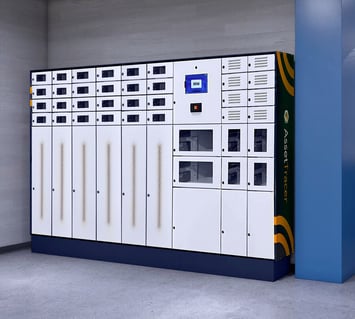
Secure storage lockers
The lockers in smart locker systems can come in various sizes and are often modular in design. This means you can combine different lockers in a stack to match unique storage requirements precisely. These lockers can have special features, including integrated power and data ports for electronic devices. They can also include climate-controlled or refrigerated compartments if you have electronics or other sensitive assets such as medications or biological samples.
Learn More: See our Ultimate Guide to Smart Lockers
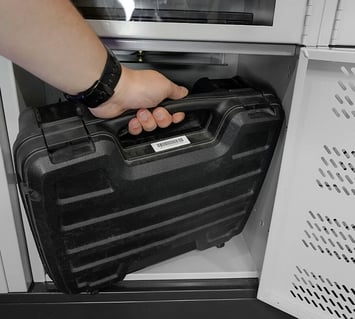
Smart access panels
Each locker system has an access control panel where staff can authenticate themselves. These panels can be simple keypads, but tablet touch screens provide advanced capabilities and workflow support options. You have the flexibility to configure the access panel to prompt users for the specific device they require, ensuring that only the designated compartment unlocks. Additionally, you can prompt users with checklists during sign-out or return, enabling the collection of essential information about the asset or its intended use.
Learn More: Electronic Access Control: How It Works & Why You Need It
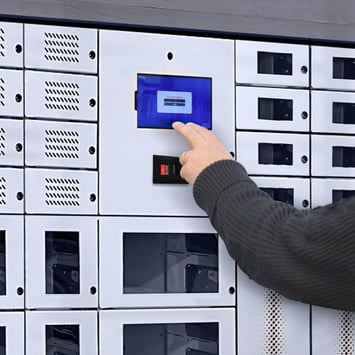
Asset surveillance
Smart lockers can do more than just store items. They can also integrate RFID sensors, scales, and other monitoring devices into locker compartments. This functionality, known as asset surveillance, allows the locker system to automatically verify that users are taking and returning the correct items and provide status information. For instance, if each component in a kit is tagged, RFID sensors can confirm whether all components are present when a user returns the kit.

Management software dashboard
Serving as the backbone of this integrated system is the software management dashboard. This interface allows you to monitor locker usage in real time, adjust user access privileges, review alerts, and generate reports tailored to your specific criteria.
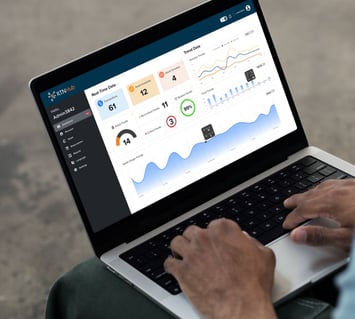
Best practices in asset maintenance management
Asset maintenance management can minimize costs, help optimize asset performance and the workflows in which they’re used, and ensure the longevity of your critical assets—in other words, maximizing your ROI. But only if you conduct your asset maintenance program effectively.
By following these best practices, you can enhance your asset maintenance program and your organization’s wider operations.
Invest in your team
 Remember: it’s never just about the technology. Tech is just there to serve your people, and your asset maintenance effectiveness is only as good as the team that supports it. Well-trained technicians are essential for properly executing and documenting maintenance work. Training should encompass maintenance procedures, detailed recordkeeping, and ongoing business improvement efforts.
Remember: it’s never just about the technology. Tech is just there to serve your people, and your asset maintenance effectiveness is only as good as the team that supports it. Well-trained technicians are essential for properly executing and documenting maintenance work. Training should encompass maintenance procedures, detailed recordkeeping, and ongoing business improvement efforts.
Gather data at every touchpoint
 Collecting and analyzing data on your assets gives you insights that lead to cost savings and informed decision-making. One key metric often tracked is the average asset lifecycle. Understanding an asset's life cycle enables you to perform preventive maintenance at critical points, extending its useful life. It also helps in planning and budgeting for eventual asset replacements.
Collecting and analyzing data on your assets gives you insights that lead to cost savings and informed decision-making. One key metric often tracked is the average asset lifecycle. Understanding an asset's life cycle enables you to perform preventive maintenance at critical points, extending its useful life. It also helps in planning and budgeting for eventual asset replacements.
Track key performance indicators (KPIs)
 Tracking key performance indicators (KPIs) enables you to improve your organization's performance continuously. Key asset maintenance KPIs, such as Mean Time Between Failures (MTBF) and Overall Equipment Effectiveness (OEE), provide daily performance insights for your physical assets.
Tracking key performance indicators (KPIs) enables you to improve your organization's performance continuously. Key asset maintenance KPIs, such as Mean Time Between Failures (MTBF) and Overall Equipment Effectiveness (OEE), provide daily performance insights for your physical assets.
Setting KPI benchmarks is an important form of goal-setting for businesses. Clear goals and actionable plans enhance your facility's overall effectiveness and efficiency.
Implement a preventive maintenance plan
 Preventive maintenance reduces costs, improves asset performance, and eliminates unplanned downtime. However, preventive maintenance schedules must be tailored to your facility's unique needs. The point of these programs is not necessarily to prevent equipment damage. They’re to prevent downtime. The first case is about technology. The latter is about overall business concerns.
Preventive maintenance reduces costs, improves asset performance, and eliminates unplanned downtime. However, preventive maintenance schedules must be tailored to your facility's unique needs. The point of these programs is not necessarily to prevent equipment damage. They’re to prevent downtime. The first case is about technology. The latter is about overall business concerns.
To create an effective preventive maintenance schedule, organize and analyze all available asset data, prioritize critical assets, and allocate maintenance funds accordingly. Continuously assess your preventive maintenance activities' performance, maintenance expenses, and effectiveness. Adjust your schedule as needed to decrease downtime further, improve asset performance, and extend asset lifespans.
Deploy a smart equipment management system
 To create an optimal inventory tracking system, determine which spare parts are commonly used in daily repairs and maintain an ideal inventory stockpile model. Choose an inventory management approach that suits your facility, and consistently stay organized. Implementing a smart equipment management system simplifies asset inventory tracking by automatically reducing stock levels during maintenance projects and prompting reorder notifications when items fall below predefined thresholds.
To create an optimal inventory tracking system, determine which spare parts are commonly used in daily repairs and maintain an ideal inventory stockpile model. Choose an inventory management approach that suits your facility, and consistently stay organized. Implementing a smart equipment management system simplifies asset inventory tracking by automatically reducing stock levels during maintenance projects and prompting reorder notifications when items fall below predefined thresholds.
Better asset maintenance management can drive your organization forward
Investing in your team and technology is an investment in the future of your facility. Well-trained technicians ensure that maintenance tasks are executed flawlessly, while technology, such as smart asset lockers, simplifies asset lifecycle management processes and streamlines operations.
Asset maintenance management systems are the key to unlocking better operational efficiency and new cost savings. By embracing the principles outlined in this article, you not only extend the life of your assets but also ensure your facility's reliability, safety, and efficiency.
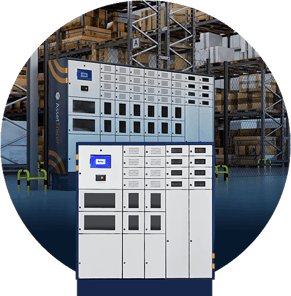
Learn how smart lockers can help your organization optimize maintenance management.
Subscribe to our blog

Jay Palter
Vice President of Marketing & Partnerships





